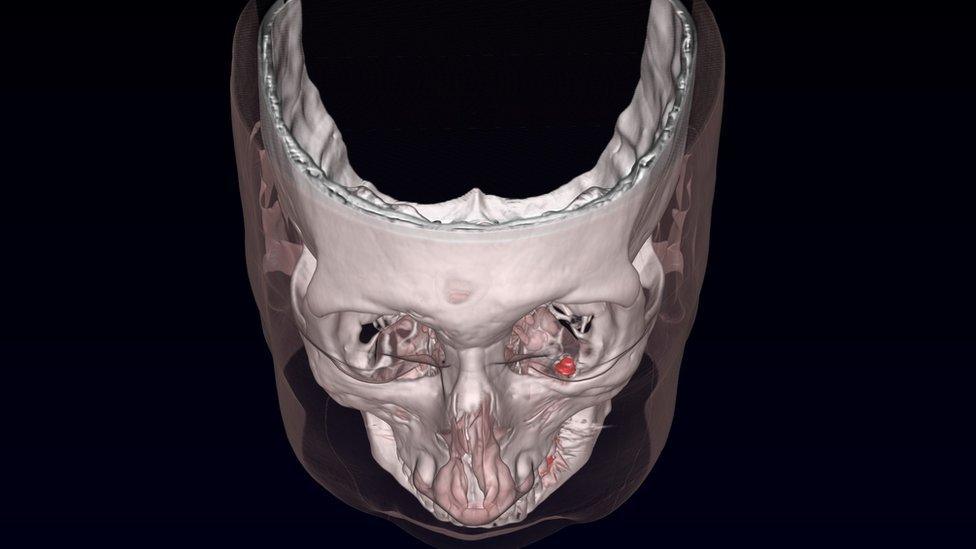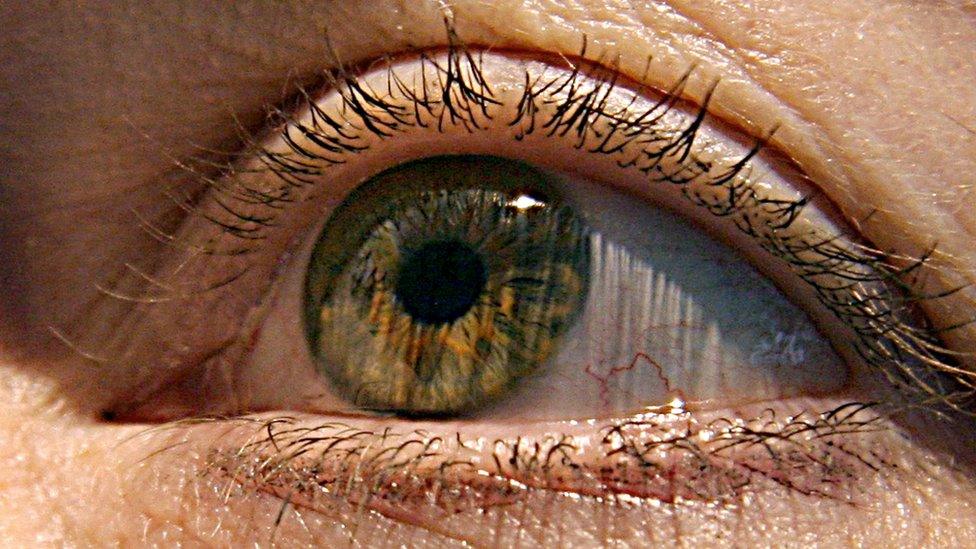Magnets used to control flickering eyes
- Published

A CT scan showing the magnet (marked in red) after the first implantation in one eye
Doctors have successfully implanted magnets behind a patient's eyes to treat a condition which causes eyes to flicker or wobble involuntarily.
Nystagmus, or 'dancing eyes' affects 1 in 1,000 people and no medical treatment is available.
The patient had two tiny magnets implanted into each eye to help overcome the eyes' flickering.
Experts claim it paves the way for greater use of magnetic implants to control the movement of body parts.
The magnets interacted with one another to impede involuntary eye movement and improve the patient's vision.
The study, led by University College London, external and the University of Oxford, external, is understood to be the first time an oculomotor prosthesis - an implant that controls eye movement - has been used successfully.
"Nystagmus has numerous causes with different origins in the central nervous system, which pose a challenge for developing a pharmaceutical treatment, so we chose to focus on the eye muscles themselves," said lead author Dr Parashkev Nachev, of the UCL's Institute of Neurology.
"But until now, mechanical approaches have been elusive because of the need to stop the involuntary eye movements without preventing the natural, intentional movements of the shifting gaze."

What is nystagmus?
Nystagmus is continuous uncontrolled to-and-fro movement of the eyes.
The movements may be in any direction so the eyes will look like they are moving from side to side or up and down or even in circles.
It is a sign of a problem with the visual system or the pathways that connect the eyes to the parts of the brain that analyse vision.
In many cases the cause of the nystagmus will not be known. The disorder cannot be cured, but some underlying conditions may be treatable.

The patient who underwent the procedure developed nystagmus in his late '40s, due to Hodgkin's lymphoma. The condition caused great impact on his life, including losing his job. His difficulties prompted the research team to build the successful prosthesis.
"Fortunately the force used for voluntary eye movements is greater than the force causing the flickering eye movements, so we only needed quite small magnets, minimising the risk of immobilising the eye," said Professor Quentin Pankhurst, of UCL, who led the design of the prosthesis.
Two magnets were implanted in each eye, one attached to the bone at the bottom of the eye socket and another sutured to one of the extraocular muscles.

In many cases the cause of nystagmus is not known
The procedure was led by Professor Geoff Rose and Mr David Verity at Moorfields Eye Hospital in London, in two separate sessions.
The patient recovered quickly and reported substantial improvements in his vision. In addition - more than four years later - there has been no reported negative impact on the functional movement of the eye. He has returned to paid employment and finds daily activities such as reading and watching television easier.
The researchers have stressed that further research still needs to be done to discover which patients would benefit most from the oculomotor prosthesis.
They warn that the magnetic implants will not be suitable for everyone with nystagmus, such as those who need regular MRI scans.
Nystagmus is the most common form of visual impairment among children.
The case study is published in Ophthalmology.
- Published11 January 2014

- Published6 July 2016